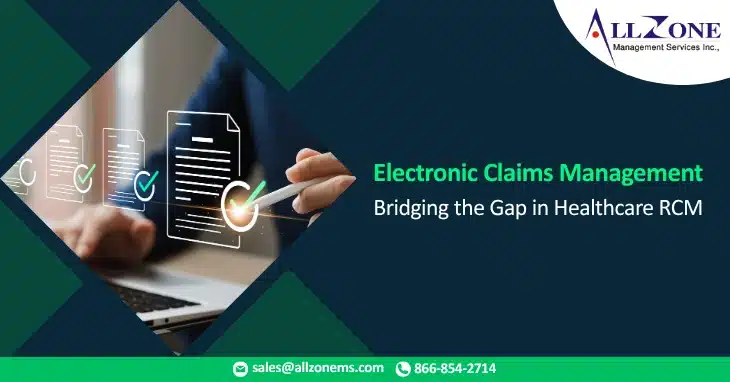The U.S. healthcare industry continues its digital transformation, with providers and payers embracing electronic transactions to streamline revenue cycle management (RCM) processes. According to the CAQH Index, adoption of electronic claims management transactions—such as eligibility verification, claim submissions, and claim status inquiries—has reached or surpassed 80% for many transaction types. However, significant gaps remain in the adoption of electronic remittance advice (ERA) and prior authorization processes, which are still largely manual and paper-driven.
In this blog, we’ll explore why electronic claims management is gaining momentum, what’s holding back full automation in remittance and prior authorizations, and how healthcare providers and payers can move toward complete digital integration.
The Shift Toward Electronic Claims Management
What Is Electronic Claims Management?
Electronic claims management refers to the use of digital platforms to process healthcare transactions such as:
- Eligibility and benefits verification
- Claims submission
- Claims status checks
- Remittance advice
- Coordination of benefits
- Prior authorization requests
These transactions are essential to RCM, and digitizing them helps reduce administrative burden, minimize claim denials, and improve financial performance for both providers and payers.
Current Adoption Rates
According to the CAQH 2023 Index:
- Eligibility and benefit verification reached 94% electronic adoption.
- Claims submission hit 97%.
- Claim status inquiry adoption is at 89%.
These figures show strong momentum toward automation and efficiency. However, the transition hasn’t been equal across all transaction types.
The Manual Bottlenecks: Remittance Advice and Prior Authorization
Despite overall progress, electronic remittance advice (ERA) and prior authorizations remain behind:
- ERA adoption is hovering around 70–75%.
- Electronic prior authorization adoption lags significantly—only about 28% of these transactions are handled electronically.
So, what’s causing the delay?
Challenges with Remittance Advice
Remittance advice provides details about claims processed by the payer, including payment status, adjustments, and reasons for denials. While ERAs offer standardized data formats (like the X12 835 transaction), several barriers still exist:
- Payer-specific variations: Despite standard formats, different payers may implement unique rules or codes, making automation complex.
- Integration issues: Many providers struggle to integrate ERA files directly into their practice management systems (PMS) or electronic health records (EHRs).
- Limited data utility: Some remittance files do not provide actionable insights, leading providers to manually reconcile payments.
Challenges with Prior Authorizations
Prior authorization is notoriously one of the most burdensome administrative processes in healthcare. Its manual nature creates delays in patient care and strains provider resources.
- Lack of payer standardization: Different payers have varying forms, documentation needs, and approval workflows.
- Communication barriers: Many requests are still made via fax or phone, creating inefficiencies.
- Technology limitations: Few EHRs and PMS platforms have fully integrated solutions to automate prior authorizations.
These challenges contribute to provider burnout, delayed treatments, and increased operational costs.
Why Digital Adoption Matters
The inefficiencies of manual processes are costly. According to CAQH:
- The healthcare industry could save over $20 billion annually by fully adopting electronic transactions.
- Manual prior authorizations cost over $10 per transaction, compared to just $1.89 electronically.
- Manual remittance advice reconciliation takes significantly more time, leading to delayed revenue recognition.
By digitizing these transactions, providers and payers can:
- Accelerate claims processing and payment timelines
- Improve cash flow and financial performance
- Reduce administrative overhead
- Enhance data transparency and reporting capabilities
Industry Push for Automation
Recognizing these issues, multiple industry initiatives are underway to streamline electronic transactions:
1. CMS and HIPAA Regulations
The Centers for Medicare & Medicaid Services (CMS) and the Department of Health and Human Services (HHS) have been promoting the use of electronic transactions under HIPAA’s Administrative Simplification provisions.
Upcoming proposed rules are expected to:
- Mandate use of FHIR (Fast Healthcare Interoperability Resources) APIs
- Standardize electronic prior authorization workflows
- Enhance real-time decision-making between providers and payers
2. CAQH CORE Operating Rules
CAQH’s CORE Operating Rules aim to unify transaction processes and promote interoperability by:
- Reducing variability in how electronic transactions are exchanged
- Setting response time requirements
- Recommending data content standards
These efforts aim to eliminate inconsistencies across payers and enable greater automation.
3. Health IT Advancements
Emerging technologies are helping providers close the gap in electronic adoption:
- AI-driven prior authorization tools reduce manual input and offer real-time guidance.
- RCM platforms with integrated ERAs allow automatic posting and reconciliation of payments.
- EHR plugins and APIs offer automated eligibility verification and electronic document routing.
How Providers Can Improve Adoption
1. Partner with an RCM Services Company
Outsourcing to an experienced RCM services company like Allzone Management Services can provide:
- Seamless integration with payers and clearinghouses
- ERA automation and analytics
- Streamlined prior authorization workflows
- Increased claims approval rate and faster reimbursements
2. Invest in EHR/PMS Upgrades
Modern platforms with API capabilities and robust claims modules can reduce manual entry and improve electronic workflow automation.
3. Train Staff and Monitor KPIs
Even with the right technology, success depends on how staff leverage it. Providers should:
- Offer training on new digital tools
- Track KPIs like days in A/R, denial rates, and remittance reconciliation time
- Regularly audit prior authorization and remittance processes for gaps
Conclusion
Electronic claims management is no longer a future trend—it’s the present reality for efficient healthcare operations. While providers and payers have made great strides in adopting electronic eligibility checks, claims submission, and claim status inquiries, remittance advice and prior authorizations still present challenges that hinder full automation.
To stay competitive and financially healthy, providers must prioritize end-to-end digital integration. Leveraging the right technology, partners, and processes will help eliminate costly bottlenecks and ensure faster, more accurate reimbursements.

